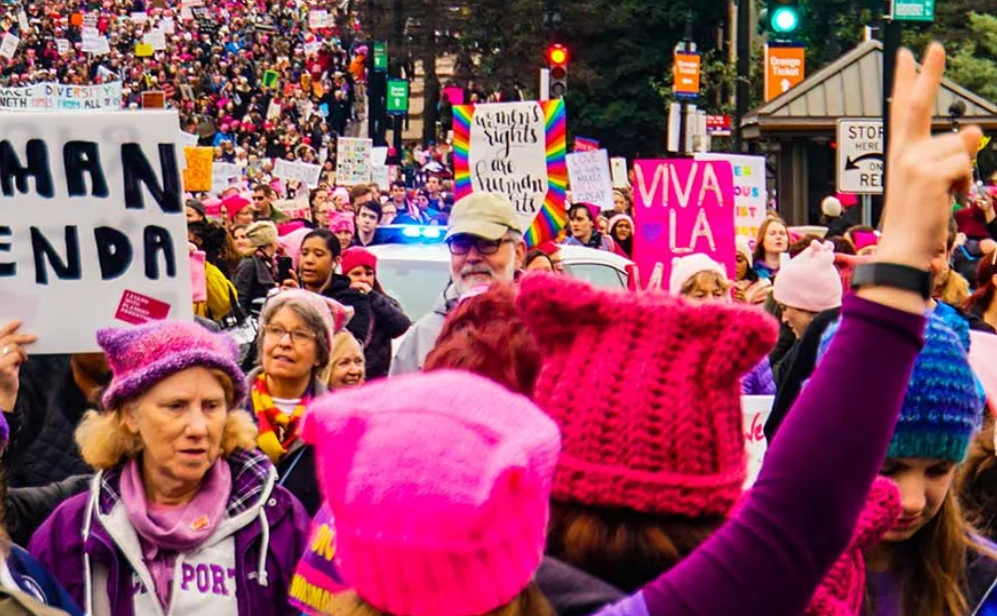
The Count: Who controls your body?

In America, the answer depends on your sex. Women’s reproduction has moved from public health policy to political ideology. Since June 2022, when Roe-vs-Wade was overturned, women no longer have a constitutional right to reproductive choice. A pregnant woman’s body is not under her control, but the government’s. The reality is that one-third, or 55 billion women, now live in “abortion deserts”. In America, abortion is about political control. It is also a numbers game. Four Supreme Court judges (three appointed by Donald Trump) withdrew bodily autonomy from 168 billion American women. Looking closer at this struggle, abortion is no longer about ideology but about law. And, at its roots, about religion.
Religion, politics, and abortion have an unsurprisingly complicated relationship. Yet, the issue of abortion and the law is not as clear cut as anti-choice Christian activists present. Trump politicised religion by pledging to overturn Roe-vs-Wade in his 2017 election run, in a bid to win Christian votes. The personal belief held by certain Christians that abortion is amoral became national health policy. For his own gain, Trump presented a synonymity between religious opposition to abortion and the necessity to legally ban abortion. A glaring problem with this, as often is true with Trump, is it is logically tenuous and realistically dangerous.
Evangelical Christianity was not always an enemy of abortion. The current anti-choice movement cites endless Bible passages, which suggests that opposition to female reproductive freedom has always been objective revealed moral guidance from God. Instead, abortion only became a talking point in mainstream Evangelical Christianity in America during the 1970s. The shift was not motivated by any divine revelation. Rather, a set of documentaries: How Should We Then Live? The Rise and Decline of Western Thought and Culture and Whatever Happened to the Human Race, produced by Frank Schaeffer, the son of Christian theologian Francis Schaeffer, were the catalysts. Frank presents abortion as incompatible with the Bible, using sensationalist art to shock his audience. From a world of pickets on Planned Parenthood clinics, there is a surprising difference between today and the 1970s: Frank was ostracised by the Evangelical community.
The church had no desire to get involved in an anti-choice movement. Abortion was not only viewed as a Catholic debate, but a private issue. Their denomination had no desire to pressure young girls and women into giving birth; private religious belief was different to political opposition to abortion access.
Outright violence towards women and girls exercising their choice was never a given. Frank’s documentary only started to galvanise Evangelical support after pro-choice activists started protesting his film choice. Schaeffer himself believes that Evangelical support for his documentaries came from anger at these feminist pro-choice activists, not anger against abortion. The mainstream church’s view towards reproductive freedom was never just about reproduction. It was fear about female emancipation from unequal gender roles that build Christian culture. Frank’s documentary created a divide: Feminists, who were pro-choice; Evangelicals, who were anti-feminist and so became anti-choice. The polarisation in the modern American abortion debate comes from this clash in the 1970s, as people were stripped of their nuance and forced into two categories.
Schaeffer never had “moral” religious reasons for his documentary. He was essentially a kid who dreamed of getting big in Hollywood and wanted to practice his skills in documentaries.
Frank is now ardently pro-choice and has devoted himself to arguing for female reproductive freedom, but this is all a little too late. The problem is that, while Frank started Evangelical anger, he is no longer in control of it. The situation has moved beyond him, and so he’s faded into irrelevancy.
So, recent history shows that Evangelical Christianity and legalised abortion are not incompatible. In fact, the two lived side by side in America. The reason why these two (now dangerously polarised) beliefs could co-exist was an Evangelical distinction between the personal and the public. Abortion is a personal decision to be made by an individual, who understands the complexities of their individual life. Why should four religiously conservative Supreme Court judges have this much control over the female body? It is both condescending and absurd for these four judges, and the current anti-choice Christian movement, to assume that they know what is best for a woman who is pregnant. You can personally decide not to get an abortion because of your faith. But that in no way equips you with the authority to make that decision for others through the passing of an abortion ban.
Rape and incest are not an exception to the abortion ban in nine states. Women and girls who have been raped, whose bodies have been violated, are told by the law that they have no autonomy over their bodies. In the face of this, an exception that anti-choice religious activists will often cite to show their humanity is the potential death of the mother. Lawmakers in abortion deserts often suggest that this is a given. Of course, if the mother is dying, she should receive medical treatment! This ‘exception to the rule’ is no new principle. In Christianity, this type of dilemma is addressed by Aquinas’ Doctrine of Double Effect. For an action that has both ‘good’ and ‘bad’ outcomes, Aquinas argues that this action is morally right if the intention is to achieve the “good” outcome. Now, Aquinas is not a theological study but legally significant. In a hospital, a doctor can perform surgery to remove a fetus if the woman’s life is severely threatened, as the intention of their action is to save a life.
This is where religion and legal policy deviate. You can believe that Aquinas’ Doctrine results in the ‘correct’ moral outcome. However, it is impossible to translate Aquinas’ Doctrine into the law of an abortion ban. For a very simple reason: you cannot create public health policy that withholds medical assistance until near-death.
Under Trump, religious belief about personal choices became law. The fact that, on the ground, the policy did was not cohesive, and at worst was reductive and dangerous, did not seem to matter to him. It does matter to the family of women who have died. Amber Thurman was a 28-year-old medical student in Georgia. She is now dead. In 2022, Amber had a medical abortion but experienced the extremely rare complication of sepsis because of retained tissue. Arriving at the Piedmont Henry Hospital with clearly worsening symptoms of sepsis, Amber was forced to wait 24 hours before a doctor was willing to operate on her due to fear of prosecution under the new Georgian abortion ban. A postmortem review determined that Amber’s death was preventable, had it not been for the delay in operation. A delay caused directly by the abortion ban. How little do we value women’s lives for them to be almost dead, to be eligible for healthcare?
Somehow, under Trump, a theological doctrine from the 1200s became an active participant in American public health policy. The result is not only a devaluation of female life, but the active contribution to female death. Many Christians do not believe that abortion is moral. That is a personal religious belief. The key point here is that personal religious belief that abortion is amoral does not translate into an abortion ban. Abortion bans influence more than an individual’s decision. A legal abortion ban carries a medley of dangerous consequences, with significant lifechanging impact on how emergency healthcare is administered. Women deserve more than for their lives to only matter once they are nearly dead.
The secondary consequences of an abortion ban are not only in the sphere of female health, but societal. ‘Anti-choice’ rather than ‘pro-life’ is the preferred term for the anti-abortion movement in this article. This is because, when the anti-choice movement became an abortion ban in 13 states, the law is pushing forced birth. Iowa, South Carolina, Georgia, and Florida have the illusion of choice. These states have a six-week ban in place. But six-weeks is one week. Length of pregnancy is not measured by from fertilisation. It is measured from the first day of a woman’s last period. Ovulation takes place in the second week of a woman’s menstrual cycle. In the eyes of the law, a pregnancy is two weeks longer than the reality. Many women do not realise that they are pregnant until a missed period (four weeks since ‘day one’), which may be attributed to stress, diet or poor sleep for up to a week. At this point, a woman is legally ‘five weeks pregnant’. She only has one week to figure out her decision, organise healthcare, and take time off work or school. One week.
American women are being divided into classes of freedom, based on financial wealth. Take the woman who only has one week before an abortion ban affects her, or one of the 55-billion women living in complete abortion deserts. Living in a state with no choice means that women must travel to a state without an abortion ban to receive treatment. Travel which costs money. In America it is as simple as, if you cannot afford to leave the state, you will have to give birth. And, if a woman cannot afford to leave the state, it is highly unlikely that she has the financial resources to support a child.
If you ask a Christian in the southern United States if they think abortion is moral, right now the answer is likely to be a no. If you ask the same person whether they would force a young girl who has been assaulted to give birth, the answer becomes less clear.
The ideological, social, and feminist arguments against abortion bans are numerous and important. However, in a polarised United States, religious arguments against abortion bans are crucial. Demonstrating that a belief in the amorality of abortion should not translate into support for an abortion ban is a step towards defusing female public health policy fired up by Trump in his last term. Kamala Harris and Donald Trump have greatly different views on women’s reproductive freedom. One directly caused an abortion ban in thirteen states and the other wants to work towards re-establishing basic respect for a woman’s right to choose. This election is an opportunity to renew the divide between private and public belief. This election is a choice between respect, autonomy, and equality. And the world is watching. ∎
Words by Eva Morgan. Image Courtesy of Ted Eytan.







